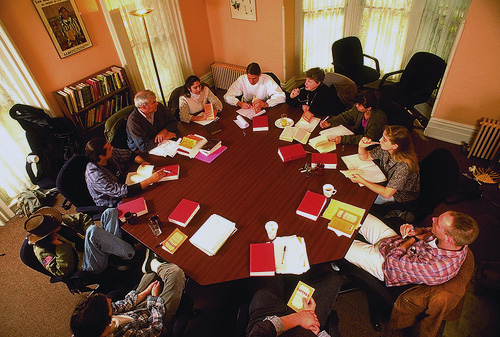Download PDF: Posadas, Ethnographic Possibilities
There are two predominant approaches to structuring an introductory course in Christian theology. More frequently, the course is organized into a series of major areas of substantive theological claims, such as the Trinity, revelation, creation, the relationship between God and humanity, sin, salvation, the Church, and so on. The other main approach is to trace the history of doctrinal development, organized around major thinkers, primary texts, or doctrinal debates that revolutionized Christian thought and practice. Each approach allows for endless variety in terms of thematic and chronological scope, genre and difficulty of readings, and confessional viewpoints represented. More importantly, an introductory course structured according to either plan can easily bring long-marginalized voices into the conversation and can convey to students the immense diversity of Christian theology at all points in its history. Both approaches can be effective for a wide range of pedagogical goals, with students at both bachelor’s and master’s levels, and in either critically comparative or critically confessional institutional contexts.
Over the past few years, however, I have been experimenting with a different way to structure an introduction to Christian theology. This was driven in part by my dissertation, in which I sought to discern layers of identity-work happening in Christian worship that can sometimes remain obscure if one considers worship primarily from a doctrinal perspective. It was also driven by my desire to make my classroom teaching of theology reflective of the same “turns to practice” that have defined many of the cutting edges of contemporary Christian theology. Is it possible, I have wondered, to structure a course so that it trains students to look for theology first as a creative process rather than as a corpus of ideas? For even before theology takes the form of texts written in different specialized languages, it arises in the lives of Christians struggling with what they regard as issues of great significance and takes shape as they imagine and contend with possible stances and responses with respect to those issues. I do not mean to deny the value of studying written articulations of Christian faith and doctrine, but the plain fact is that all such texts are the remnant of myriad layers of interpersonal and communal interactions (mediated, to be sure, both verbally and otherwise). Without the interactions, there would be no written texts!
In emphasizing this relationship between written theology and the interactions that are its source, I am drawing upon a distinction that has been important in the subfield of Christian liturgical theology between “primary” and “secondary” theology. The late, eminent liturgical theologian Aidan Kavanagh provides one of the classical articulations of the difference. In contrast to theology “done in academies out of books by elites with degrees producing theologies of this or that,” Kavanagh emphasizes the importance of studying “theology being born, theology in the first instance … [w]hat tradition has called theologia prima.”1 Primary theology is theology that arises in the understandings of religious practitioners, in the flow of actual religious experiences.2 Kavanagh maintains that this theology, no less than the work of academy-based theologians, has critical content to which a careful student of theology pays close attention: indeed, Kavanagh maintains that secondary theology must be understood as always derivative from primary theology.
Not all teachers of theology will accept a conceptual or a hierarchical distinction between primary and secondary theology, but if one allows for the possibility that it names an important difference, then it calls into question whether the best or only proper object of study in an introductory course in Christian theology is theology in the forms it has been given by academically trained professionals and/or ecclesially authorized interpreters. If such theology is derivative from “theology being born,” then might not the first task be to train students’ perceptual and analytical abilities so that they can thoughtfully appreciate this first-order theology, as it transpires among actual “primary theologians”? What course materials best allow students to critically encounter the process of primary theologizing? And what activities can enhance students’ acuity for detecting the flow of primary theology?
The question of course materials effective for studying primary theology opens up the possibilities of working with ethnographic material. Contemporary ethnography of Christian communities is not, of course, the only sort of material that discloses primary theology for critical study. But it does offer some excellent pedagogical benefits that can challenge and deepen students’ understandings. First of all, it tends to de-privilege secondary theology, particularly that produced by theologians in elite positions (in either ecclesial or academic hierarchies) relative to the majority of those who practice Christianity. The ideas of academic theologians serve primarily as background, and while clergy perspectives are often included, these are the perspectives of local leaders responding to needs in their particular context, rather than writing for or about “the Church” in the abstract. Conversely, the perspectives of lay Christians are explicitly brought to the fore, correcting for the persistent bias against them in representations of Christian theology. This is important, of course, because laypeople constitute the majority of Christian practitioners (and always have).
In addition to exposing students to an expanded range of perspectives, engaging ethnographic literature can reveal to students both fuller processes by which theology emerges and a wider scope of activities that form theology, compared to a focus on doctrines as intellectual artifacts or monuments. For instance, much of the material in the course I teach presents moments of conversation in the midst of quotidian tasks in the community. Students can practice tracing in such moments different threads of meaning and interest, drawn from different moral discourses, as they are woven together into theological claims (or also as they unravel from one another). Ethnographic materials can also allow students to see the mutual interplay between theological values and the pragmatic solutions of communal problems: theology offers (often competing) terms in which to understand and address concrete problems, while problems also provoke new ways of thinking theologically. Certainly one can study the classical doctrines and controversies of Christian theology with a similar mindset, but early-year undergraduates may find it easier to understand the theological process in contemporary, local-community examples, while also understanding more about concerns faced by Christians that they may actually encounter in their own lives.3
Now, as I have been redesigning the introductory course along ethnographic lines, I have integrated two registers of material that are not “ethnographic” in the same senses. On the one hand, I have featured several ethnographies proper, written mostly by sociologists or anthropologists of religion. These scholars have undertaken fieldwork in one or a few particular communities and have engaged in both participant observation and one-on-one interviews, as well as documentary research. The organizing questions are framed social-scientifically, in terms of cultural or structural processes and identities. Because this is a course in theology and not sociology or anthropology of religion, I have considered only works that regard the faith claims of practitioners not as something to be explained away, but as claims to be understood sympathetically, if also critically; we are fortunate that there are a number of excellent options available nowadays. I have brought these ethnographies into conversation with another kind of writing: memoirs and other firsthand accounts of Christian practitioners themselves. These are not written as scholarly analyses and are not ethnographies in any strict sense. But in critically studying them, students can assume an ethnographic stance without doing violence to them as narratives. Indeed, I have chosen accounts that lend themselves to such study, opting, for example, for memoirs that reflect on everyday life in more-or-less typical congregations, rather than “heroic” memoirs of the individual experiences of famous church leaders. This methodologically hybridized approach, therefore, yields an introduction to the perception and analysis of primary theology from various ethnographic stances. How does this stance play out in the design of the course? I will now briefly describe some of the major elements.
Incorporating an Ethnographic Stance in Course Design
Course Objectives
I teach undergraduates, and the introductory course can fulfill general education distribution requirements, so the objectives are framed for the students with respect to the general framework of liberal education:
Through engagement with a variety of Christian communities (mostly by means of texts written by or about them), with each other, and with our own broader communities, we will develop and enhance the following abilities:
To analyze and understand the practices, values, beliefs, and contentions by which different localChristian communities define themselves as “Christian.”
To analyze and understand the struggles by which Christian individuals shape their lives as Christians in the world.
To engage in critical conversation with other members of the class—for the sake of mutual learning—on the matters named in (1) and (2).
To lead critical conversation in public settings on the matters named in (1) and (2).
To create critical argumentsof one’s own and to respectfully evaluate and respond to others’ critical arguments, based on support from course materials, other sources of evidence, and sound reasoning.
Because the course consists largely of first-year students, I do not use the language of “primary” and “secondary” theology heavily in either the syllabus or in the first half of the semester, instead initially presenting concrete examples of each level of theological activity and eventually making the terms of the distinction explicit. Moreover, I do not define “theology” itself more specifically than practical struggles, individual and communal, to live as Christians in the world. By proceeding with an ethnographic agnosticism about what “theology” itself is, students are encouraged to pay attention to what counts as theological in a given local context, rather than presuming that theology is only what secondary theologians say it is.
One will note that the fourth objective calls for active, public critical thought about theology as we discover it in the course. This stems not only from my college’s educational mission, which emphasizes leadership as one of the chief outcomes of liberal education, but also from the American Academy of Religion’s white paper “The Religion Major and Liberal Education.”4 That document declares that there is a “growing consensus about the characteristics of the religious studies major” in undergraduate liberal education programs across many contexts of institutional control. Out of the five defining characteristics of the major—and, by extension, courses in religious studies—public engagement in some form comprises significant portion of three:
Critical: The major teaches students to examine and engage religious phenomena, including issues of ethical and social responsibility…. Integrative: The major applies theoretical knowledge of religious phenomena to lived, practical contexts, both historical and current…. Creative and Constructive: The major employs … the skills of religious studies in the solving of complex problems, including those raised in the personal and social engagement of issues of life, death, love, violence, suffering, and meaning.5
The paper is a valuable resource for anyone teaching theology, even if in a more confessional context or ministry-aimed program.
Readings
As described above, the readings divide broadly into two kinds: memoirs and other firsthand accounts of religious practitioners, and ethnographies proper, largely written by sociologists or anthropologists of religion. I begin with the memoirs, because they are more accessible writing. Each term I use two to three of the following, all of which I have used at least once:
- Heidi Neumark, Breathing Space: A Spiritual Journey in the South Bronx, ISBN: 0807072575;
- Sara Miles, Take This Bread: A Radical Conversion, ISBN: 0345495799;
- Dennis Covington, Salvation on Sand Mountain: Snake Handling and Redemption in Southern Appalachia, ISBN: 0306818361;
- Barbara Brown Taylor, Leaving Church: A Memoir of Faith, ISBN: 0060872632;
- Samuel Freedman, Upon This Rock: The Miracles of a Black Church, ISBN: 0060924594;
- Nancy Mairs, Ordinary Time: Cycles in Marriage, Faith, and Renewal, ISBN: 0807070572;
- Richard Lischer, Open Secrets: A Memoir of Faith and Discovery, ISBN: 0767907442;
- Finally, I have not yet used but am considering using Donna Johnson’s Holy Ghost Girl, ISBN: 1592407358.
In addition, I have generally sprinkled throughout the semester two to three one-off class-sessions on film or radio materials:
- Dead Man Walking, directed by Tim Robbins (1996);
- Amazing Grace, directed by Michael Apted (2007);
- This American Life, episode 304, “Heretics,” on Pentecostal minister Carlton Pearson.6
For the more strictly ethnographic materials, each term I have featured selections from at least two of the following:
- Marla Frederick, Between Sundays: Black Women and Everyday Struggles of Faith, ISBN: 0520233948;
- Peter Gathje, Sharing the Bread of Life: Hospitality and Resistance at the Open Door, ISBN: 0971589321;
- Christian Smith and Melinda Lundquist Denton, Soul Searching: The Religious and Spiritual Lives of American Teenagers, ISBN: 0195384776;
- Charles Marsh, God’s Long Summer: Stories of Faith and Civil Rights, ISBN: 0691130671;
- Mary McClintock Fulkerson, Places of Redemption: Theology for a Worldly Church, ISBN: 0199591504;
- Claire Wolfteich, Lord, Have Mercy: Praying for Justice with Conviction and Humility, ISBN: 0787982695.
Additionally, near the end of the semester, I include selections from one of these works, which early-year students find significantly more challenging conceptually and stylistically than the preceding:
- Dawne Moon, God, Sex, and Politics: Homosexuality and Everyday Theologies, ISBN: 0226535126;
- Bethany Moreton, To Serve God and Wal-Mart: The Making of Christian Free Enterprise, ISBN: 0674057406;
- In coming terms I plan to also include Tanya Luhrmann’s When God Talks Back: Understanding the American Evangelical Relationship with God(ISBN: 0307277275) and Richard Wood’s Faith in Action: Religion, Race, and Democratic Organizing in America (ISBN: 0226905969) in this more advanced list.
Some notes about the above lists may be helpful. Take This Bread and Salvation on Sand Mountain are consistently the most popular readings for students. While they like the ideas of Breathing Space, its more episodic narrative structure requires some guidance. Strictly speaking, Soul Searching and God’s Long Summer are not ethnographies—one is qualitative research based on surveys and follow-up interviews, the other is a form of cultural history through collective biography—but each includes profiles that have an ethnographic inflection and depth. Finally, all the texts in the second list require (at least for early-year undergraduates, and possibly more advanced students depending on their prior education) carefully unpacking the author’s research aims and appreciating how they are similar to and different from the questions in the course.
In-Class Activities
In addition to unpacking the arguments of course texts, other activities shaped from an ethnographic stance can refine students’ attention to primary theology. For instance, I have had students watch the music videos for several recent award-winning Christian popular songs, identifying common patterns of representation and elements of the theological discourse in which they are embedded. Students always find a similar analytical exercise done with the prominent Christian dating websitewww.ChristianMingle.com both enjoyable and generative of unexpected insights. Some might see the theological content discernible in these sources as too unsophisticated, relative to secondary theology, to be worthy of critical study. But precisely because millions of living Christians are theologizing in these media—far more than they do in books of secondary theology—they are worth paying attention to. Debates in which students have to role-play and argue from different perspectives encountered in a given course text have also proven effective in leading students to understand the multiple, competing strands of thought that come together in Christians’ theological claim-making.
Larger Assignments
The course includes a longer reflection paper at the end of the semester, in which students compare theological themes raised by different readings. This is complemented by other assignments that require students to practice skills of ethnographic understanding. In some semesters, I have had students post on Facebook links to two to three news stories culled from websites I have designated for the project. (These websites intentionally span the theo-ideological spectrum, fromwww.ReligionDispatches.org to www.ChristianityToday.com, along with www.AU.org, the website of Americans United for the Separation of Church and State.) Students use Facebook’s comment feature to even-handedly explicate theological commitments operating in the situation reported in the story, after which they can offer any personal evaluations or responses they desire. Having students engage in this analysis on Facebook—without any requirement that they personally agree with anything in the articles—is a way to encourage students to bring the questions we pursue in class into a public they create with their close relationships.
In other semesters, I have had students read one of the memoirs from the above list that we are not reading that semester for in-class discussion. Students write an analytical book review midway through the semester. They then create, by the end of the semester, a plan for leading a multi-week book group on the book: devising questions to increase readers’ comprehension, identifying issues that would be important to engage in group discussion, and designing creative activities by which participants could synthesize their responses to and insights from the book. In this project students assume the role of guiding others through ethnographic encounters with actual Christian communities. Eventually, I would like to incorporate field observation of local Christian communities into the course, but this requires both established relationships with those communities and working through the procedures for research involving human subjects.
Conclusion
Students trained in the critical study of Christian theology should be able to distinguish theology as a whole phenomenon from the written texts that have been one of the major forms it has been given over the millennia. Perhaps the most significant pedagogical benefit of an introductory course structured from an ethnographic stance is that it makes human interactions, rather than verbal formulations, the fundamental unit for the analysis of theology. High-quality ethnographic materials—both formal ethnographic studies and firsthand reflections written with an ethnographic imagination—present many of the kinds of interactions that drive theological production. Although these interactions are the source of all theologizing, they have long gone under-considered in both the study and teaching of theology. Engaging ethnographic materials begins to correct this imbalance by allowing students to “observe” the process of theological emergence as it unfolds, and, thereby, train their analytic abilities to comprehend the various elements and dynamics in that process.7 An ethnographic approach encourages students to develop a more comprehensive method for theological investigation, which has room for, but is not limited to, the analysis of relations among theological concepts.
Notes
- Aidan Kavanagh, On Liturgical Theology(Collegeville, MN: Pueblo/Liturgical Press, 1984), 74-75.
- Liturgical theologians assert, moreover, that the site par excellence for the emergence of primary theology is in Christian worship. Without making this assumption, however, the concept can be usefully deployed in thinking about a whole range of Christian practices, both those frequently practiced alongside worship (such as pastoral care or religious education) and those of either an everyday piety or a para-ecclesial nature.
- The ethnographic approach I describe here can effectively serve as a launching pad for further historical study, and my own introductory course is designed with a glance toward the intermediate-level historical survey I offer. As much as one can compellingly argue that, if a student is only going to take one theology course, she or he would be best served by an emphasis on history-of-doctrines literacy, one can also compellingly argue that she or he would best be served by honing skills for interpreting present-day Christian communities.
- American Academy of Religion, “The Religion Major and Liberal Education,” 2008,http://www.aarweb.org/programs/Religion_Major_and_Liberal_Education/default.asp(accessed February 22, 2013).
- Ibid., 11-12, emphasis added.
- This American Life, “Heretics,” episode 304, http://www.thisamericanlife.org/radio-archives/episode/304/heretics (originally aired Dec. 2005).
- Discerning this process at work with more historical materials is possible, but doing it well requires studying various kinds of social-cultural and political background that could prove too onerous for a student who is just beginning with the critical study of theology.






